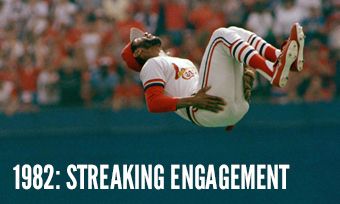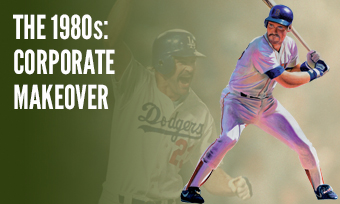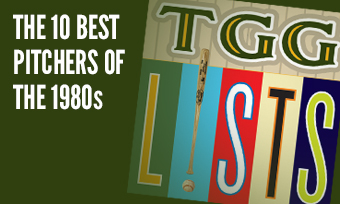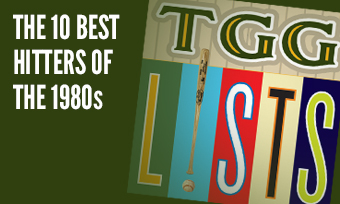The Yearly Reader
Leaders and Honors, 1982
Our list of baseball’s top 10 hitters and pitchers in both the American League and National League for the 1982 baseball season, as well as the awards and honors given to the game’s top achievers of the year.
The National League’s Top 10 Hitters, 1982
Bold type in brick red indicates league leader.
1. Dale Murphy, Atlanta
Key Numbers: 162 games, .281 average, 113 runs, 36 home runs, 109 RBIs, 93 walks, 23 stolen bases.
Playing every game, hitting at least 36 home runs and driving in at least 100 runs for the first of four straight years, Murphy became the first Atlanta Brave to win the NL MVP. (Hank Aaron, in 1957, was the last Brave honored when the team was back in Milwaukee.)
2. Mike Schmidt, Philadelphia
Key Numbers: .280 average, 108 runs, 26 doubles, 35 home runs, 87 RBIs, 107 walks, 14 stolen bases, .403 on-base percentage, .547 slugging percentage.
Some Phillies fans might have found disappointment in Schmidt’s HR/RBI totals—which matched those of 1981, during a much shorter season—but he still had the league’s highest OPS (on-base + slugging percentages) at .950.
3. Pedro Guerrero, Los Angeles
Key Numbers: .304 average, 87 runs, 175 hits, 27 doubles, 5 triples, 32 home runs, 100 RBIs, 22 stolen bases.
Guerrero became the first Dodger to go .300-30-100 since Duke Snider and Roy Campanella both did it in 1955 for Brooklyn’s lone champions.
4. Lonnie Smith, St. Louis
Key Numbers: .307 average, 120 runs, 182 hits, 35 doubles, 8 triples, 8 home runs, 69 RBIs, 9 hit-by-pitches, 68 stolen bases, 26 caught stealing.
Ozzie Smith made his St. Louis debut, but it was another Smith, Lonnie, who for now had the better year at the plate, after falling out of favor with Phillies general manager Paul Owens.
5. Al Oliver, Montreal
Key Numbers: .331 average, 90 runs, 204 hits, 43 doubles, 22 home runs, 109 RBIs.
Claiming to be 35 pounds lighter, Oliver said hello again to the NL after four years as a DH and skewered opposing pitchers like never before.
6. Andre Dawson, Montreal
Key Numbers: .301 average, 107 runs, 183 hits, 37 doubles, 7 triples, 23 home runs, 83 RBIs, 39 stolen bases.
The Hawk went back to emphasizing speed over power, nabbing a career-high 39 bags while hitting fewer homers than during the strike-shortened 1981 campaign.
7. Leon Durham, Chicago
Key Numbers: .312 average, 84 runs, 33 doubles, 7 triples, 22 home runs, 90 RBIs, 28 stolen bases.
Twenty-five NL players received at least one MVP vote. Durham, continuing to impress in his second full year, was not one of them.
8. Jason Thompson, Pittsburgh
Key Numbers: .284 average, 87 runs, 32 doubles, 31 home runs, 101 RBIs, 101 walks.
While fellow Pirates continued to disappoint (Dave Parker) or just grow too old (Willie Stargell, Bill Robinson), Thompson became the offensive savior with a strong effort that evoked his breakout years with the Tigers in the late 1970s.
9. Bill Madlock, Pittsburgh
Key Numbers: .319 average, 92 runs, 181 hits, 33 doubles, 19 home runs, 95 RBIs, 18 stolen bases.
Madlock had one of the more curious box score lines on September 14 against the Cubs with the following line: 2-1-1-6. His one hit was a grand slam, and he knocked in two more runs on sacrifice flies.
10. Bill Buckner, Chicago
Key Numbers: .306 average, 657 at-bats, 93 runs, 201 hits, 34 doubles, 5 triples, 15 home runs, 105 RBIs, 15 stolen bases.
Buckner put aside trade rumors after patching up with manager Lee Elia after they fought in the middle of a game early in 1982. It was his first of two career 200-hit seasons.
The American League’s Top 10 Hitters, 1982
1. Robin Yount, Milwaukee
Key Numbers: .331 average, 129 runs, 210 hits, 46 doubles, 12 triples, 29 home runs, 114 RBIs, 14 stolen bases, .578 slugging percentage.
It what was clearly the best season of his Hall-of-Fame career, Yount floored it away from home (.347), against lefties (.357), with runners in scoring position (.375) and after July 1 (.350).
2. Hal McRae, Kansas City
Key Numbers: .308 average, 91 runs, 189 hits, 46 doubles, 8 triples, 27 home runs, 133 RBIs.
McRae fattened up on his numbers after needed weight loss, knocking in 100-plus runs for the only time in his career.
3. Dwight Evans, Boston
Key Numbers: 162 games, .292 average, 122 runs, 178 hits, 37 doubles, 7 triples, 32 home runs, 98 RBIs, 112 walks, .402 on-base percentage.
The 11th-year Red Sock followed a surprisingly productive 1981 campaign with yet another, further cementing a late-career blossoming.
4. Rickey Henderson, Oakland
Key Numbers: .267 average, 119 runs, 10 home runs, 51 RBIs, 116 walks, 130 stolen bases, 42 caught stealing.
After averaging 25 steals a month and breaking Lou Brock’s season record before the end of August, Rickey cooled off and swiped a relatively few seven more bags over the A’s final 30 games.
5. Eddie Murray, Baltimore
Key Numbers: .316 average, 87 runs, 174 hits, 30 doubles, 32 home runs, 110 RBIs, 18 intentional walks.
Shy but not combative with the press, Murray wore a necklace that spelled out his character: Just Regular. His idea of “regular” was the above numbers.
6. Cecil Cooper, Milwaukee
Key Numbers: .313 average, 104 runs, 205 hits, 38 doubles, 32 home runs, 121 RBIs.
Cooper maintained good contact hitting—becoming part of the first trio of AL teammates (Robin Yount, Paul Molitor) to each collect 200 hits in the same year since the 1937 Tigers, while turning up the power to a career-high total in home runs.
7. Paul Molitor, Milwaukee
Key Numbers: .302 average, 666 at-bats, 136 runs, 201 hits, 26 doubles, 8 triples, 19 home runs, 71 RBIs, 41 stolen bases.
Along with Robin Yount—with whom he’d be Brewers in arms for 15 years—Molitor made a quantum leap toward future Hall-of-Fame consideration.
8. Toby Harrah, Cleveland
Key Numbers: 162 games, .304 average, 100 runs, 183 hits, 29 doubles, 25 home runs, 78 RBIs, 84 walks, 12 hit-by-pitches, 17 stolen bases.
The ornery Harrah lived a bittersweet year that started by hitting close to .400 well into June while criticizing the Indians for not improving the team around him.
9. Fred Lynn, California
Key Numbers: 138 games, .299 average, 89 runs, 38 doubles, 21 home runs, 86 RBIs.
After an awful (.131) second half in his first year at Anaheim, Lynn rebounded back to All-Star form, earning his eighth straight Midsummer Classic roster spot.
10. Reggie Jackson, California
Key Numbers: .275 average, 92 runs, 39 home runs, 101 RBIs, 85 walks, 156 strikeouts.
A Toronto writer spoiled Robin Yount’s bid for a unanimous AL MVP by giving Jackson, at long last free of George Steinbrenner and Billy Martin, a first-place vote.
The National League’s Top 10 Pitchers, 1982
1. Steve Rogers, Montreal
Key Numbers: 2.40 ERA, 19 wins, 8 losses, .704 win percentage, 35 starts, 277 innings, 24 grounded into double plays.
Once paying his dues with 22 losses for the fledgling 1974 Expos, Rogers finally got some well-deserved payback in 1982.
2. Joe Niekro, Houston
Key Numbers: 2.47 ERA, 17 wins, 12 losses, 35 starts, 5 shutouts, 19 wild pitches, 27 stolen bases allowed.
The best pitcher amid a sterling and veteran (Nolan Ryan, Don Sutton) Astros staff, the 37-year-old Niekro produced his best ERA within a 22-year career.
3. Fernando Valenzuela, Los Angeles
Key Numbers: 2.87 ERA, 19 wins, 13 losses, 37 starts, 18 complete games, 285 innings.
A superb sophomore campaign after his storied 1981 breakout, though there was disappointment in that he failed to win either of his last three starts to earn a 20th win.
4. Steve Carlton, Philadelphia
Key Numbers: 3.10 ERA, 23 wins, 11 losses, 38 starts, 19 complete games, 6 shutouts, 295.2 innings, 286 strikeouts, 9 balks, 25 grounded into double plays.
Carlton continued to amaze and took his fourth and final Cy Young Award, even after handicapping himself with a 0-4 start. Had the rest of the Phillies’ staff pitched as well against the Cardinals as he did (5-1, 2.37 ERA in six starts), the Phillies might have taken the NL East instead.
5. Joaquin Andujar, St. Louis
Key Numbers: 2.47 ERA, 15 wins, 10 losses, 37 starts, 5 shutouts, 265.2 innings, 50 walks.
One of the reasons the Cardinals did win the NL East was because of Andujar, who in his first full year at St. Louis went 4-0 with a 1.43 ERA against the Phillies in five assignments.
6. Jerry Reuss, Los Angeles
Key Numbers: 3.11 ERA, 18 wins, 11 losses, 37 starts, 254.2 innings, 50 walks.
Two years after throwing a no-hitter, Reuss completed a pair of one-hitters—with the lone hits each coming in the first inning.
7. Don Sutton, Houston
Key Numbers: 3.00 ERA, 13 wins, 8 losses, 27 starts, 195 innings, 25 stolen bases allowed.
The latter, transitory stage of Sutton’s career was status quo as the 37-year-old ace was dealt to the contending Brewers in late August—helping them with a 4-1 record down the stretch to win the AL East.
8. Mario Soto, Cincinnati
Key Numbers: 2.79 ERA, 14 wins, 13 losses, 34 starts, 257.2 innings, 274 strikeouts, 24 stolen bases allowed.
While the Reds were stuck in Baseball 101 (as in 101 losses), Soto showed he was more master than student.
9. Greg Minton, San Francisco
Key Numbers: 1.83 ERA, 10 wins, 4 losses, 30 saves, 7 blown saves, 78 appearances, 123 innings, 17 intentional walks.
The Moon Man’s five home runs were the first he’d given up since 1978—but from June 22 on, he didn’t give up much of anything else, going 7-0 with a 1.13 ERA and 19 saves.
10. Phil Niekro, Atlanta
Key Numbers: 3.61 ERA, 17 wins, 4 losses, .810 win percentage, 35 starts, 234.1 innings.
The 43-year-old knuckler was no longer exhausting himself with 300-plus innings like the late 1970s—but he didn’t need to anyway as he was given the best run support (5.4 runs per start) of his career.
The American League’s Top 10 Pitchers, 1982
1. Jim Palmer, Baltimore
Key Numbers: 3.13 ERA, 15 wins, 5 losses, .750 win percentage, 1 save, 36 appearances, 32 starts, 227 innings.
An initially iffy but ultimately satisfying last hurrah for Palmer, who was demoted to the bullpen early in the year before storming back to win 13 of 14 decisions in a late stretch.
2. Dan Quisenberry, Kansas City
Key Numbers: 2.57 ERA, 9 wins, 7 losses, 35 saves, 9 blown saves, 72 appearances, 136.2 innings, 12 walks.
A Kent Tekulve disciple with his submarine-style delivery following shoulder problems in college, Quisenberry became the AL’s premier closer.
3. Dave Stieb, Toronto
Key Numbers: 3.25 ERA, 17 wins, 14 losses, 38 starts, 19 complete games, 5 shutouts, 288.1 innings.
The efforts of Stieb were good enough to help ascend the Blue Jays out of expansionist futility, if not yet out of the AL East cellar.
4. Bob Stanley, Boston
Key Numbers: 3.10 ERA, 12 wins, 7 losses, 14 saves, 2 blown saves, 48 appearances, 0 starts, 168.1 innings, 24 grounded into double plays.
The ultra-long reliever; 11 of Stanley’s appearances lasted five innings or longer. Of those games, he won eight and lost only once.
5. Mike Witt, California
Key Numbers: 3.51 ERA, 8 wins, 6 losses, 33 appearances, 26 starts, 179.2 innings, 47 walks, 2 stolen bases allowed, 11 caught stealing/picked off.
Might as well finish what you started; Witt only won two of his 24 starts in which he didn’t go the distance.
6. Dan Petry, Detroit
Key Numbers: 3.22 ERA, 15 wins, 9 losses, 35 starts, 246 innings, 100 walks, 26 grounded into double plays.
Though all those Jack Morris wins in the 1980s got abundant praise, it could be argued that the underrated Petry was actually the better Tigers pitcher early in the decade.
7. Geoff Zahn, California
Key Numbers: 3.73 ERA, 18 wins, 8 losses, .692 win percentage, 34 starts, 229.1 innings, 32 grounded into double plays.
The 36-year-old southpaw earned much of his three-year, $1.2 million contract with, easily, his best year as an Angel.
8. Bill Caudill, Seattle
Key Numbers: 2.35 ERA, 12 wins, 9 losses, 26 saves, 6 blown saves, 70 appearances, 95.2 innings.
Nicknamed “Inspector” for his penchant of imitating a detective, Caudill solved many a tight game in Seattle’s favor.
9. Rick Sutcliffe, Cleveland
Key Numbers: 2.96 ERA, 14 wins, 8 losses, 1 save, 34 appearances, 27 starts, 216 innings, 26 stolen bases allowed, 17 caught stealing/picked off.
The former Rookie of the Year whose stock with the Dodgers fell so low that he once angrily tore apart manager Tommy Lasorda’s office, Sutcliffe finished a wonderful comeback effort in Cleveland by sending a “How Am I Doin’ Now!” postcard to Los Angeles.
10. LaMarr Hoyt, Chicago
Key Numbers: 3.53 ERA, 19 wins, 15 losses, 39 appearances, 32 starts, 239.2 innings, 48 walks, 24 stolen bases allowed.
Hoyt rose to prominence after being among the first of George Steinbrenner’s minor-league giveaways that netted him veterans (in this case, the Yankees got Bucky Dent in return).









